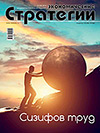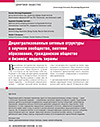Decentralized Network Structures in the Scientific Community, the Educational System, Civil Society and Business: the Hirama Model
The present work focuses on the applications of decentralized network structures with split leadership to various spheres of society. They are denoted herein as hiramas (High-Intensity Research And Management Associations). Special emphasis is placed on the use of hiramas in the organization of nontraditional interdisciplinary creative labs and NGOs in civil society, interactive teaching, and in business. It is stressed that the importance of traditional hierarchical institutions exemplified by universities and academic research institutions is not diminished by the spread of alternative decentralized network structures. Hierarchical institutions are to be held responsible for the consolidation and self-identification of the national scientific community, for furthering the interests of the scientific community in the face of external and internal challenges, and for evaluating the performance of decentralized network structures to select the hiramas that should receive material and ideological support.
References:
- Kolesova L.A., Kurdyumov V.S., Oleskin A.V. Setevye struktury, matriks i shaperony. Prakticheskie vozmozhnosti i organizatsionnye shagi [Network Structures, the Matrix, and Chaperones. Practical Options and Organizational Innovations]. Ekonomicheskie strategii, 2017, no 5, pp. 94–105.
- Oleskin A.V., Budanov V.G., Kurdyumov V.S. Sotsial’nye shaperony [Social Chaperons]. Ekonomicheskie strategii, 2016, no 7, pp. 92–100.
- Oleskin A.V., Kurdyumov V.S. Setevye struktury: optsii v mire zhivogo i chelovecheskom sotsiume. O setevom sotsializme [Network Structures: Options in Living Nature and Human Society. Network Socialism]. Ekonomicheskie strategii, 2015, no 7, pp. 74–85.
- Oleskin A. V., Kurdyumov V. S. Setevye struktury, matriks i shaperony [Network Structures, the Matrix, and Chaperones]. Metafizika, Nauchnyy zhurnal, 2017, no 2 (24), pp. 11–27.
- Zakharov A.A. Differentsiatsiya funktsiy i dominirovanie v razvitii biosotsial’nosti [Functions Differentiation and Domination in the Development of Biosociality]. Zoologicheskiy zhurnal, 2005, t. 84, no 1, pp. 38–53.
- Kirovskaya T.A. Issledovaniya populyatsionnoy organizatsii i mezhkletochnoy kommunikatsii u mikroorganizmov v Sovetskom Soyuze (Rossii) vtoroy poloviny XX veka [Research of Population Organization and Intercellular Communication Among Microorganisms in the Soviet Union (Russia) in the Second Half of the 20th Century]. Dis. … kand. biol. nauk. Moscow, Institut istorii estestvoznaniya i tekhniki, 2005.
- Oleskin A.V. Setevye struktury v biosistemakh i chelovecheskom obshchestve [Network Structures in Biosystems and Human Society]. Moscow, URSS, 2012, p. 301.
- Oleskin A.V. Setevoe obshchestvo: ego neobkhodimost’ i vozmozhnye strategii postroeniya [Network Society: the Need for It and Possible Strategies for Its Construction]. Moscow, URSS, 2016
- Kavtaradze D.N. Obuchenie i igra. Vvedenie v aktivnye metody obucheniya [Learning and Playing. Introduction to Active Teaching Methods]. Moscow, Flinta, 1998.
- Davydova S.I., Mardar’ I.B., Usacheva O.A. Lidery i seti sovremennykh ekologicheskikh dvizheniy [Leaders and Networks of Modern Environmental Movements]. Istoriya i sovremennost’, 2008, no 2, pp. 117–127.
- Putnam R.D. Bowling Alone: The Collapse and Revival of American Community. New York, Simon & Schuster, 2000.
- Alberts D.S., Garstka J.J., Stein F.P. Network Centric Warfare: Developing and Leveraging Information Superiority. CCRP Publication Series, 2000
- Rich A. Think tanks, public policy, and the politics of expertise. Ph. D. Dissertation. Yale University, 1999.
- Rimskiy V.L., Sungurov A.Yu. “Fabriki mysli”, tsentry demokratii i tsentry publichnoy politiki [“Thought Factories”, Democracy Centers and Centers of Public Policy]. “Fabriki mysli” i tsentry publichnoy politiki: mezhdunarodnyy i pervyy rossiyskiy opyt [“Thought Factories” and Centers of Public Policy: International and the First Russian Experience]. Pod redaktsiey A.Yu. Sungurova, Saint Petersburg, Norma, 2002, pp. 6–29.
- Mezhuev V.M. Grazhdanskoe obshchestvo i sovremennaya Rossiya [Civil Society and Modern Russia]. Chelovek i kul’tura v stanovlenii grazhdanskogo obshchestva v Rossii [Man and the Culture in the Civil Society Formation in Russia]. Moscow, IFRAN, 2008, p. 6.
- Habermas J. Moral Consciousness and Communicative Action. Cambridge (MA): MIT Press, 1990, p. 46.
- Poldervaart S. W. The utopian or DiY-strategy of social movements // Hierarchy and Power in the History of Civilization. 5rd Int. Conf. / Ed. D. M. Bondarenko, O. I. Kavykin. Moscow: Center for Civilizational and Regional Studies of the RAS, Institute for African Studies of the RAS, 2009.
- Lijphart A. Democracy in Plural Societies. New Haven: Yale University Press, 1977.
- Mikhalko M. Kak provesti mozgovoy shturm produktivno: osnovnye tekhniki i estestvennoe tvorcheskoe myshlenie [How to Brainstorm Productively: Basic Techniques and Natural Creative Thinking]. Entsiklopediya marketinga, 2015, available at: http://www.marketing.spb.ru/lib-mm/tactics/Creative-Thinking_Techniques.htm.
- Vachkov I. Osnovy tekhnologii gruppovogo treninga. Psikhotekhniki [Fundamentals of Group Training Technology. Psychotechnics]. Ucheb. posobie. Moscow, Os’-89, 2001, p. 60.
- Brown L.L., Acevedo B., Fisher H.E. Neural correlates of four broad temperament dimensions: testing predictions for a novel construct of personality. Plos One. 2013. doi.org/10.1371/journal.pone. 0078734.



